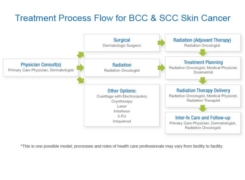Skin eBx™
Why Surface eBx?
The system enables the clinician to administer surface brachytherapy without the use of a radioactive isotope or a megavoltage linear accelerator, making surface treatments more accessible at locations where no vault exists and eliminating treatment delays by expanding access to radiation therapy.
eBx simplifies the surface radiation process with improved targeting of the tumor site using a direct contact applicator and a flexible clamp. The lightweight surface applicator (less than 150g) can be precisely oriented to the desired location on the patient (target lesion). With the reduced shielding requirement of eBx, the physician can remain near the patient. Furthermore, faster dose fall-off of the low-energy miniaturized X-ray source minimizes exposure to healthy adjacent tissues.
Technology Comparison
Compared to electron beam therapy, the Axxent® surface brachytherapy system allows a more precise set-up with continuous monitoring, which might allow smaller margins with smaller treatment fields, potentially leading to fewer treatments of higher doses with similar cosmetic results. The delivered field with the Axxent® source has sharp fall-off edges (the 80–20 penumbral transition width is under 3 mm versus 10–12 mm of MeV electrons)1, which allows field sizes as small as 1 cm in diameter. The applicator has been designed to deliver homogenous dose over 90% of the target area. With the ability to plan the field accurately within 1 mm of the desired treatment site, a smaller area can be used to deliver the treatment dose. A target area between 1 cm and 5 cm in diameter over a range of treatments allows for optimal dose application. With the combination of ease of placement, precision of dose delivery and small applicator size, almost any externally accessible area on the body can be treated (for example buccal mucosa of the oral cavity)2.
The lower energy electronic source has lower shielding requirements than either electron treatments or Iridium isotope therapy.
-The radiation delivery can be conducted in a minimally shielded room.
-The non-toxic Flexishield material can be easily cut to size for individual field shaping.
-Near-ocular treatments using thin tungsten eye-shields are possible.
-Bolus buildup for shallow surface lesions will be unnecessary.
Facts About Skin Indications
One in six Americans develops skin cancer at some point with over a million cases annually in the U.S.3,4 Most patients are diagnosed with non-melanoma skin cancer (NMSC) with basal cell carcinoma being the most common in 80% and squamous cell carcinoma representing 20%. The majority of lesions are located on sun-exposed areas like face, backs of hands and neck. According to the NCCN guidelines5 radiation therapy is a treatment option for primary NMSC treatment or secondary in case of positive margins post-surgical. Keloid scarring is another indication that is most suitable for surface brachytherapy. Surgical excision of keloid formation is usually only effective 20–50% of the time with surgery alone. With combined surgery and radiation therapy, the treatment is successful over 80% of the time.6
Treating with eBx
eBx is administered under the direction of a radiation oncologist. In cooperation with the dermatologist, the radiation oncologist will determine the amount of radiation needed and the physicist will ensure that the radiation is delivered as prescribed. eBx can be delivered on an outpatient basis in a room with reduced shielding requirements. Treatment regimen and prescription depend on tumor size, type, depth, patient age, prior treatments and other criteria. During radiation therapy, the surface applicator is connected to the system's Controller. The treatment site is prepared with a flexible shield that is cut to shape to surround the target area and protect the adjacent non-target tissues. A miniaturized X-ray source is placed in the applicator and energized to deliver radiation for a few minutes. At the completion of the treatment, the X-ray source is turned off. All devices are removed in between treatment fractions.
1 Perez CA, Brady LW. Principles and Practice of Radiation Oncology. Third edition. Lippincott, Williams & Wilkins: 1998.
2 Sabbas AM, et al. HDR Brachytherapy with Surface Applicators: Technical Considerations and Dosimetry. Technology in Cancer Research & Treatment 2004. Vol 3(3); 259–267.
3 National Cancer Institute 2008: http://www.cancer.gov/cancertopics/types/skin
4 American Cancer Society, Cancer Facts and Figures 2008: http://www.cancer.org/downloads/STT/2008CAFFfinalsecured.pdf
5 National Comprehensive Cancer Network: http://www.nccn.org/professionals/physician_gls/f_guidelines.asp
6 Lawrence WT. In search of the optimal treatment of keloids: report of a series and a review of the literature. Ann Plast Surg 1991;27:164–78.
|

 |